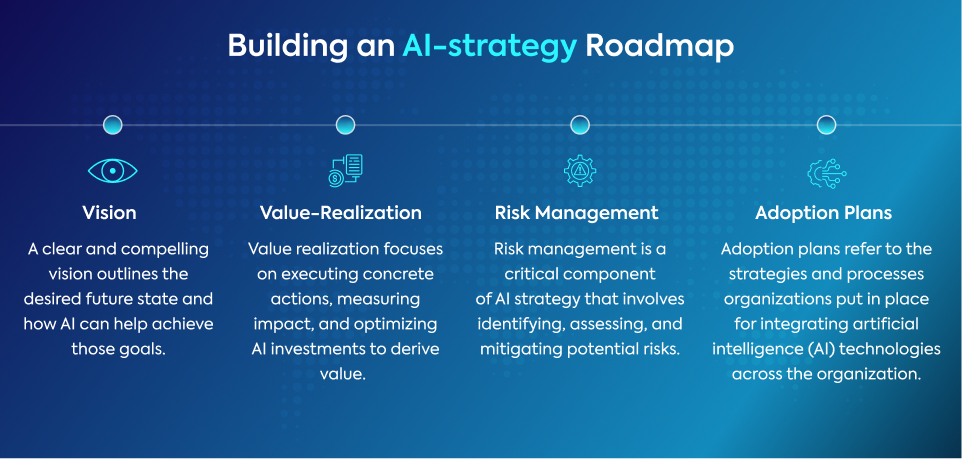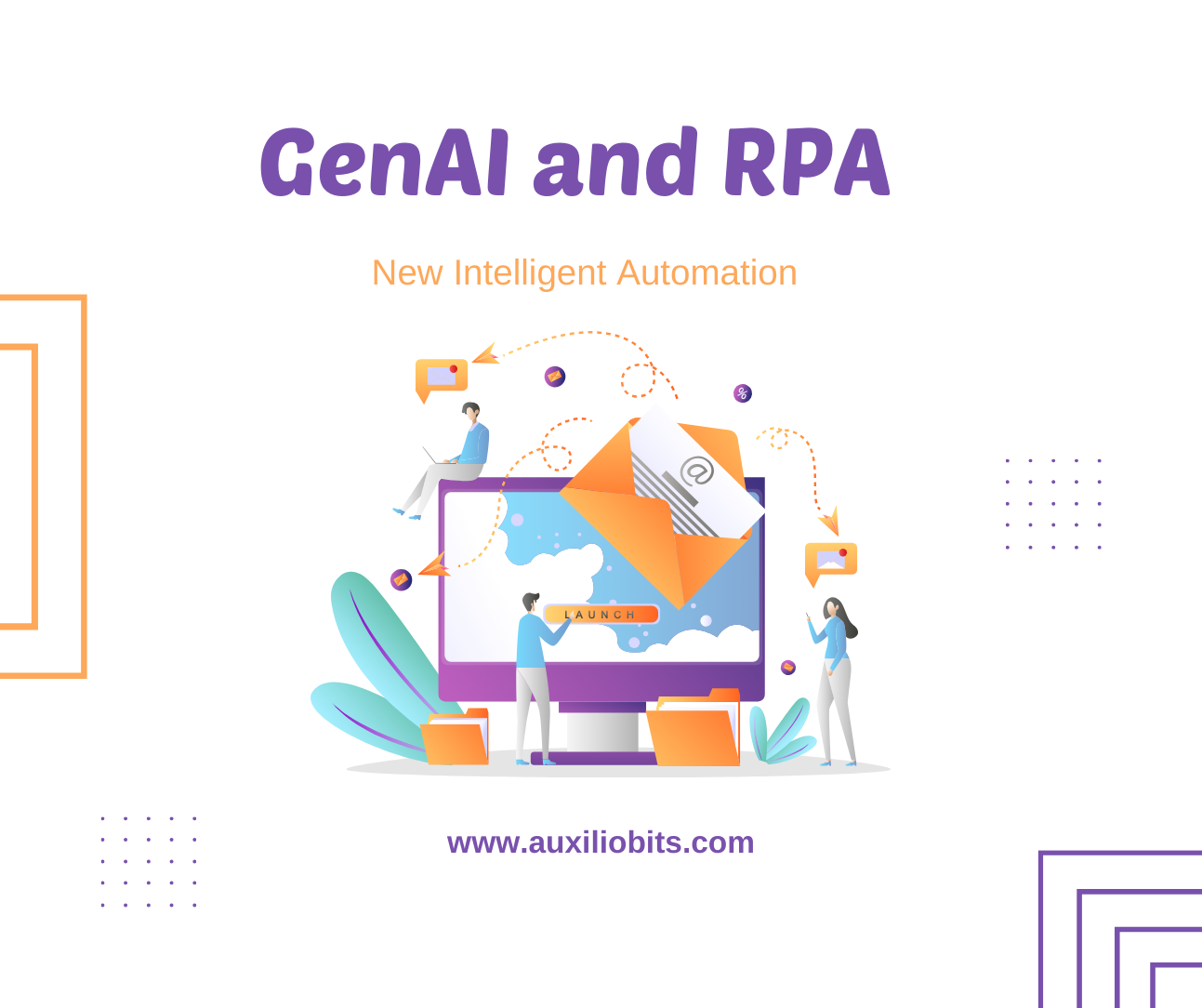Key Takeaways
- An effective AI strategy roadmap demands a comprehensive understanding of your business objectives, market dynamics, and the potential of AI technologies to guide you through the intricate journey of implementing AI solutions that drive tangible value and sustainable growth.
- A successful AI strategy can be created by fortifying the four essential pillars: Vision, Value-Realization, Risk Management, and Adoption Plans.
- The strategy must be aligned with the vision, must have a long-term perspective, ensure cross-functional collaboration while prioritizing ethical AI practices.
- The AI-strategy must provide tangible benefits to drive organizational success.
- Risk management is a critical component of AI strategy that involves identifying, assessing, and mitigating potential risks.
- Successful adoption and integration of AI into existing business processes, workflows, and culture is crucial for realizing the full potential of AI investments.
- By embracing AI strategy roadmaps, organizations can drive innovation, deliver superior customer experiences, and achieve sustainable growth in the digital age.
In today’s fast-changing business environment, it has become imperative for organizations to adopt Artificial Intelligence (AI) striving to stay ahead of the competition, foster innovation, and deliver better customer experiences.
However, getting the most out of AI requires more than just deploying cutting-edge technology. An effective AI strategy roadmap demands a comprehensive understanding of your business objectives, market dynamics, and the potential of AI technologies to guide you through the intricate journey of implementing AI solutions that drive tangible value and sustainable growth.
How to Build an AI-strategy Roadmap?

The AI-strategy can be developed systematically by reinforcing its four pillars:
- Vision
A vision is more than just a statement. It is a promise to progress and a commitment to work toward our goals while upholding our values and principles. A clear and compelling vision acts as the guiding beacon for AI initiatives within an organization. It outlines the desired future state and how AI can help achieve those goals.
Here are some important things to consider for crafting a robust AI vision:
- Alignment with Business Objectives
The vision should align seamlessly with the business objectives and corporate strategy. A clear AI vision not only complements existing objectives but also enhances them. It emphasizes creating value by increasing revenue, reducing costs, improving customer satisfaction, or enhancing operational efficiency by harnessing the transformative power of AI. This alignment ensures AI initiatives contribute to deriving meaningful outcomes rather than being pursued in isolation.
- Long-Term Perspective
A strong vision extends beyond just pursuing immediate goals. Having a clear vision requires looking into the future and working towards achieving short-term goals simultaneously. It is necessary to maintain a long-term perspective to stay focused on the bigger picture. Anticipating future market trends, technological advancements, evolving customer needs, and other factors ensure that AI initiatives remain relevant and impactful in changing times. This forward-looking approach enables organizations to future-proof strategies and stay competitive in the dynamic business landscape.
- Cross-Functional Collaboration
Developing an AI vision requires collaboration across various business functions, including IT, operations, marketing, and finance. It necessitates inputs from stakeholders from different departments and disciplines within the organization to gain diverse perspectives and ensure buy-in and support for AI initiatives. This cross-functional approach considers the distinct challenges and opportunities, providing actionable insights for efficient optimization across all spheres.
- Ethical and Responsible AI
Ethical considerations are an integral part of the AI vision. It requires inculcating principles like transparency, fairness, accountability, and confidentiality to build trust among customers, employees, and other stakeholders. Prioritizing ethical AI practices not only mitigates risks but also enhances the reputation and credibility of the organization in the marketplace. Responsible and ethical use of AI technologies demonstrates the organization’s commitment to being a trusted steward.
- Value-Realization
It’s essential to have a solid vision when it comes to AI investments. However, it’s equally important to realize tangible value from those investments. Value realization refers to translating the potential benefits of AI initiatives into tangible outcomes that contribute to organizational goals and success. It focuses on executing concrete actions, measuring impact, and optimizing AI investments to derive value.
Here’s how you can strengthen this key pillar:
- Define Measurable Goals
The first step in value realization is to define clear and measurable goals that align with the strategic objectives of the organization. These goals should be specific, achievable, and time-bound, allowing us to measure the success of AI initiatives. For example, goals may include increasing revenue, reducing costs, improving customer satisfaction scores, or increasing operational efficiency.
- Establish Key Performance Indicators (KPIs)
Once goals are defined, the next step is to establish key performance indicators (KPIs) to track progress and measure the success of AI initiatives. KPIs may vary depending on the nature and type of the project. Setting up relevant KPIs provides insights into the performance of AI systems and helps evaluate their overall effectiveness. Examples of KPIs include return on investment (ROI), customer retention rates, conversion rates, and productivity gains.
- Data-Driven Decision Making
Data is the fuel that powers AI algorithms to generate high-quality insights and drive decision-making. Organizations can extract actionable insights from data to take strategic actions and optimize performance through the use of advanced analytics and machine learning techniques. Investing in data management processes, quality assurance, and governance ensures that data is accurate, accessible, and fit for successful value realization with the help of AI applications.
- Iterative Improvement
Value realization requires continuous monitoring, evaluation, and refinement of AI initiatives. To achieve this, organizations need to embrace a culture of experimentation and learning. Organizations should gather feedback from stakeholders, evaluate performance against KPIs, and identify areas for improvement. It helps optimize AI models, algorithms, and processes to increase profitability and achieve better outcomes over time.
- Risk Management
Risk management is a critical component of AI strategy that involves identifying, assessing, and mitigating potential risks. AI introduces a range of risks and challenges, including ethical concerns, regulatory compliance, and cybersecurity threats in algorithmic decision-making. Proactive management of these risks associated with the deployment and utilization of artificial intelligence (AI) technologies is crucial to ensure responsible and ethical AI adoption.
To make this pillar stronger, organizations can follow the steps mentioned below:
- Ethical Frameworks and Guidelines
Ethical considerations are paramount in AI risk management, given the potential for AI systems to impact individuals, communities, and society as a whole. Organizations must develop and adhere to ethical principles such as fairness, transparency, accountability, privacy, and human rights when designing, deploying, and using AI technologies. It means ensuring that AI systems are unbiased and transparent and align with ethical standards and societal values.
- Regulatory Compliance
AI initiatives must comply with data privacy, security, and consumer protection laws. Organizations need to stay abreast with regulatory requirements and establish controls to ensure AI initiatives adhere to legal and ethical standards. It may involve conducting legal reviews, obtaining regulatory approvals, and implementing compliance measures throughout the AI lifecycle.
- Bias Detection and Mitigation
AI algorithms are susceptible to biases leading to unfair or discriminatory outcomes. Organizations should implement techniques such as bias detection, fairness testing, and algorithmic transparency. These techniques help identify and mitigate biases, ensuring equitable treatment, particularly in hiring, lending, and criminal justice. Ensuring AI systems train on diverse and representative datasets so that decisions are explainable and understandable to stakeholders is equally important.
- Cybersecurity and Data Protection
AI introduces new cybersecurity risks, including data breaches, adversarial attacks, and manipulation of AI systems. Organizations should implement robust cybersecurity measures, such as encryption, authentication, and intrusion detection, to protect sensitive data from unauthorized access, manipulation, or theft. Regular security audits should be carried out as well to detect and address potential vulnerabilities in AI systems.
- Adoption Plans
Adoption plans refer to the strategies and processes organizations put in place for integrating artificial intelligence (AI) technologies across the organization. Successful adoption and integration into existing business processes, workflows, and culture is crucial for realizing the full potential of AI investments.
Organizations can maximize the impact of AI adoption by following the steps below:
- Change Management
Effective change management facilitates the transition to AI-enabled workflows and processes with minimal resistance, fostering a culture of innovation and collaboration. Change management entails communicating the benefits of AI initiatives, providing training and support to employees, and addressing concerns proactively to facilitate smooth transitions and minimize disruptions.
- Skill Development and Talent Acquisition
Building a skilled workforce capable of leveraging AI technologies is essential for driving successful adoption. Investing in employee skill development through training, workshops, and certifications helps organizations effectively support AI initiatives and fill critical roles.
- Cross-Functional Collaboration
Collaboration across different business functions is essential for alignment, coordination, and synergy throughout the organization, driving effective AI adoption and integration. Adoption plans facilitate interdisciplinary teamwork, break down silos, and encourage knowledge sharing to ensure alignment of AI initiatives with business objectives.
- Scalability and Sustainability
Scalable and sustainable plans allow organizations to expand AI initiatives gradually and integrate them seamlessly into long-term strategic plans. By building flexible architectures, investing in scalable infrastructure, and adopting agile methodologies to adapt to changing business requirements and technological advancements, organizations can ensure that AI initiatives grow and evolve with the organization’s needs and objectives over time.
- User Experience Design
User experience design provides intuitive, user-friendly, and tailored AI solutions. It is crucial to prioritize the continuous design and refinement of AI interfaces and applications to offer an easy-to-use, visually appealing, positive user experience. Focus on user-centric design principles to enhance user adoption and satisfaction with AI solutions.
- Measurement and Feedback
Incorporate mechanisms for measuring the effectiveness and impact of AI initiatives and gather feedback from users and stakeholders to identify areas for improvement. AI adoption is an ongoing process that requires continuous monitoring, optimization, and iteration. Use key performance indicators (KPIs) to track adoption rates, user satisfaction, productivity gains, and other relevant metrics for making relevant adjustments to plans. Embracing a culture of continuous improvement can realize long-term benefits from AI investments.
Case Studies: Driving Value with AI Strategy Roadmaps
To illustrate the effectiveness of AI strategy roadmaps in driving business value, let’s look at two real-world case studies:
- Amazon
Industry: Retail/E-commerce
Amazon is one of the world’s largest e-commerce platforms, implementing AI strategies across various divisions, including product recommendations, inventory management, and logistics optimization. By leveraging AI-powered analytics, Amazon has been able to analyze customer behavior and purchasing patterns and personalize marketing campaigns to enhance customer experience. It has significantly improved customer satisfaction, increased sales revenue, and enhanced operational efficiency. Additionally, AI-driven demand forecasting and inventory optimization algorithms aid in reducing stockouts, minimizing overstocking, and streamlining orders.
- IBM Watson Health
Industry: Healthcare/Technology
IBM Watson Health is a division of IBM using AI and data analytics to improve patient care and healthcare delivery. AI-powered chatbots and virtual assistants assist in scheduling appointments, accessing medical information, and receiving personalized health recommendations 24/7. It reduces the burden on administrative staff and improves patient satisfaction. Furthermore, predictive analytics and risk stratification models helped the organization identify high-risk patients, proactively manage chronic conditions, and optimize resource allocation, leading to better health outcomes and cost savings.
In conclusion
AI-powered business strategies are essential for thriving in today’s dynamic environment. To succeed, businesses must have a clear vision, robust value-realization strategies, proactive risk management, and effective adoption plans. Real world case studies are illustrations of the transformative power of AI. By embracing AI strategy roadmaps, organizations can drive innovation, deliver superior customer experiences, and achieve sustainable growth in the digital age.
If you want to integrate AI-based systems to your business, connect with the experts at Auxiliobits! We help our clients select the best AI tools for their business and guide them through deployment of these tools with a planned strategy!
Call Us Now for Customized Solutions for your Business!




 July 19, 2024
July 19, 2024
